Colorado is home to more than two hundred spider species. Some are considered venomous, while others are completely harmless to humans and pets.
Continue reading to identify the most common spiders you may encounter in Colorado.
Table of Contents
1. Bold Jumping Spider
Scientific name: Phidippus audax
Common name: daring jumping spider, bold jumping spider.
The bold jumping spider belongs to the Salticidae family, with the ability to jump more than four times its body length, which enables it to ambush prey and escape predators.
It’s unlikely to get bitten by one of these spiders, as they are not easy to catch.
They are not dangerous to humans and if bitten, it will be no worse than a bee sting.

These spiders vary in color and behavior. They are black with a white line that runs on the upper part of the abdomen with two white dots close to the rear. Their legs and pedipalps are hairy.
Bold jumping spiders are the most popular spiders in Colorado. They live in homes, cars, offices and garages, sheds, and barns.
2. Western Black Widow
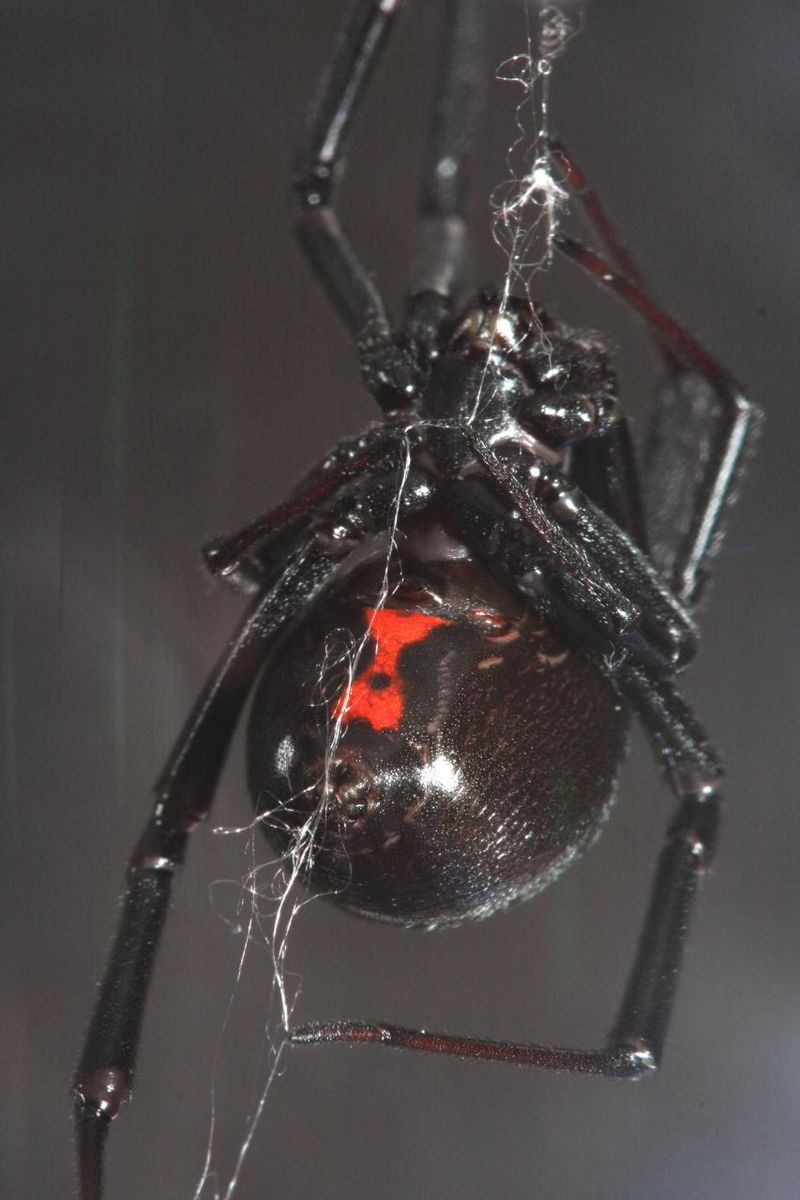
Scientific name: Latrodectus hesperus
Common name: western black widow, western widow.
Western black widows are venomous spiders you may encounter in Colorado.
Females grow to 16mm in body length and are the only venomous ones, males are considered harmless. The female is shiny black and hair a red hourglass on her belly. The hourglass can vary in color from yellow to even white.
The female black widow has a potent venom, which can include pain, sweating, chills, nausea, and vomiting. Bites are very rare and fatalities as a result of bites are also very rare.
If bitten by a black widow or you think you may have been bitten by one of these spiders, seek immediate medical attention.
Further Reading:
3. Habronattus festus
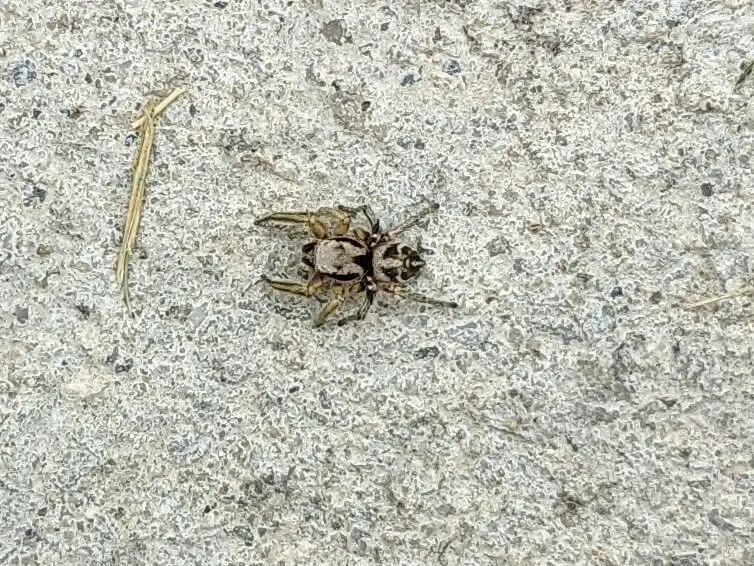
This jumping spider belongs to the Salticidae family.
It does not spin a web to catch prey, but rather uses its excellent jumping ability to ambush its prey as they shoot out a single strand of silk, helping to capture the prey. The spider then drags their prey to its web.
These spiders are generally harmless to humans and seldom bite.
4. Woodlouse Spider

Scientific name: Dysdera crocata
Common name: woodlouse hunter, sowbug hunter, sowbug killer, pillbug hunter, slater spider
A female adult woodlouse spider is larger than the male, growing to 0.59 inches (15mm) in body length. Males grow to 0.39 inches (10mm) in body length.
They have an orange to dark red head space and legs with a shiny beige or yellow/brown abdomen.
They are commonly found under rocks, plant pots, leaf litter, and bricks. They do make their way into homes.
5. Cat-faced Orbweaver

Scientific name: Araneus gemmoides.
Common name: Cat-faced spider, jewel spider.
The cat-faced orbweaver is a harmless orb-weaving spider with two bumps on the top of the abdomen, which creates the ears of the cat face. The body pattern is the face.
They are upside-down spiders, sitting in their webs with their heads facing down.
They vary in color from pale to rich brown.
6. Zebra Jumping Spider

Scientific name: Salticus scenicus
Common name: zebra jumping spider
Zebra jumping spiders are harmless spiders that can jump more than four times their body length.
The female can grow to 9mm in body length, while the male is smaller, growing to 6mm in body length.
They belong to the Salticidae family. These are small spiders with black and white hairs that form stripes.
7. Apache Jumping Spider

Scientific name: Phidippus apacheanus.
Common name: Apache jumping spider.
The Apache jumping spider belongs to the Salticidae family, known for its excellent jumping abilities when it comes to ambushing prey or escaping predators.
Due to their speed, they are not easy to catch and therefore bites are very rare.
8. Goldenrod Crab Spider

Scientific name: Misumena vatia
Common name: goldenrod crab spider, flower (crab) spider.
The Goldenrod crab spider uses camouflage as a defense. They will bite to protect themselves. They can change their color over a few days, helping them blend into their environment. They can change from green to bright yellow in about a week.
They are ambush spiders and sit in the center of a flower waiting for pollinating insects. They have very long front legs, which enables the spider to grab prey that is much bigger than they are.
Males are smaller with black front legs and pale green legs with a white/cream abdomen with two dark red lines down the center.
Females are a solid color with a rounded abdomen.
Further Reading:
9. Asiatic Wall Jumping Spider

Scientific name: Attulus fasciger
Common name: Asiatic Wall Jumping Spider
The Asiatic wall jumping spider is a black to brown colored jumping spider that grows to around 4mm in body length.
They originally come from Asia and were introduced to North America in the 1950s.
They are common in and around homes where insects are abundantly attracted to artificial night lights.
10. Northern Yellow Sac Spider

Scientific name: Cheiracanthium mildei.
Common name: Northern yellow sac spider.
The Northern yellow sac spiders are often encountered in Colorado, often found in offices and homes.
These spiders can be yellow-white to light green with darker legs and brown jaws.
They are nocturnal and hunt at night. They can be seen in the corner of ceilings at night. They are common in gardens, where they hide under the bark.
They are considered venomous in that their bite can cause skin irritation.
11. California Flattened Jumping Spider

Scientific name: Platycryptus californicus.
Common name: California flattened jumping spider.
The California flattened jumping spider belongs to the Salticidae family.
These jumping spiders do not create webs to ensnare prey. Their webs are their homes and a safe place to eat once they have ambushed their prey and dragged them back to their webs.
These small spiders are not dangerous to humans and are not aggressive. Don’t be fooled, they will bite if provoked, which will be no worse than a bee sting.
12. Spotted Orbweaver

Scientific name: Neoscona crucifera
Common name: Hentz orbweaver, spotted orbweaver, barn spider.
The spotted orbweaver has the ability to spin an orb-shaped web that can reach up to two feet in diameter. They hide during the day, sitting at the edge of the web.
They can vary in color from orange to red, yellow to brown, or tan. Some have a pattern on their abdomens, others have dark zigzag lines down the sides. They all have bristles on their body, legs, and head.
These nocturnal spiders can be encountered in fields, parks, backyards, gardens, and woodlands.
13. Banded Garden Spider

Scientific name: Argiope trifasciata
Common name: banded garden spider, banded orb weaving spider.
The banded garden spider is an orb-weaver spider that creates an orb-shaped web in garden beds. They sit upside down in the center of the web, waiting for prey to get caught.
Their belly, which is dark in color, is facing south, helping the spider absorb more heat.
Colors vary with some being red to brown with white banding, others are black with yellow and white banding. Webs are built low to the ground between tall grass or shrubs.
14. Triangulate Combfoot

Scientific name: Steatoda triangulosa
Common name: triangulate cobweb spider, triangulate bud spider.
The triangulate combfoot spider grows to 6mm in body length.
They have a brown to orange head space, cream-colored abdomen, and yellow hairy legs. Their abdomen is bulb-shaped with purple to brown zigzag lines.
15. Eastern Parson Spider

Scientific name: Herpyllus ecclesiasticus
Common name: Eastern parson spider.
Eastern parson spiders have a white stripe on their abdomen that looks like the ruffled tie that was worn by men in the clergy back in the eighteenth century.
They are medium-sized spiders, they are hairy and fast.
They are ambush predators, roaming walls and the ground at night searching for insects.
They hide under rocks and debris during the day. They are often encountered in homes and buildings.
They will bite if provoked and their bite is known to cause an allergic reaction in some people.
16. Oblong Running Spider
Scientific name: Tibellus oblongus.
Common name: Oblong running spider.
Oblong running spiders are medium-sized spiders that belong to the crab spider family.
They are found in grass and herbaceous plants in a variety of habitats.
They have long, flattened, slender, and hairy bodies with females growing up to three eighths of an inch.
They have a broad brown stripe with narrow lateral stripes on the head space, with a long and cylindrical abdomen, which is yellow to brown or brown with darker brown markings.
They have a dark broad stripe with two narrower stripes and a small spot at the end of each stripe on their abdomens. Their legs are slender and long.
17. Texas Brown Tarantula
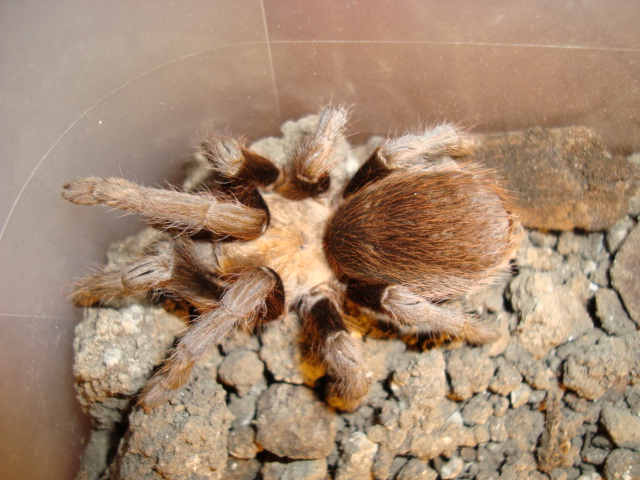
Scientific name: Aphonopelma hentzi.
Common name: Texas brown tarantula, Oklahoma brown tarantula, Missouri tarantula.
The Texas brown tarantula is a harmless spider that is feared because they are hairy, fast, and large. They are two-toned, often seen outdoors.
They are brown on the head space and abdomen with darker legs. The legs have a gray to white color to them. The body is covered in orange hairs that the spider uses to rub off if threatened. If these hairs get into your skin, they can cause irritation.
They are not aggressive and will run for cover if they feel threatened. They may raise and stretch out their front legs to make them look bigger than they are.
These tarantulas are often encountered in farmlands and open fields. They are known to accidentally make their way indoors.
Further Reading:
18. Carolina Wolf Spider
Scientific name: Hogna carolinensis.
Common name: Carolina wolf spider.
The Carolina wolf spider is the largest wolf spider in North America, with females growing to 35mm in body length and males to 20mm in body length.
They are mottled brown with a dark belly. Males have some orange on their sides.
They live in burrows and are ambush predators.
19. Habronattus cuspidatus
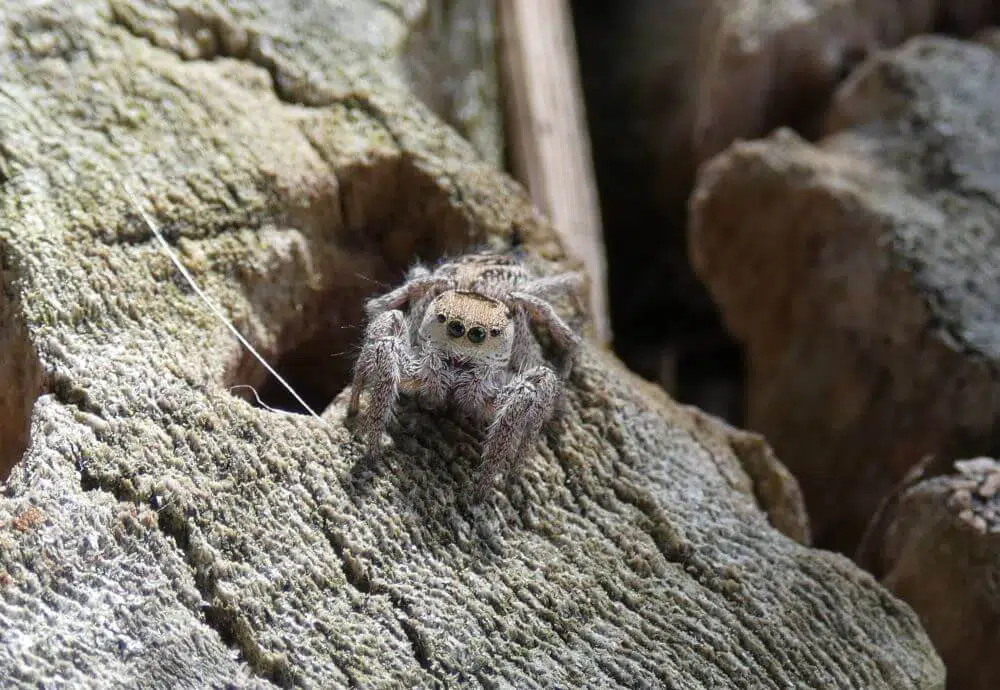
This jumping spider belongs to the Salticidae family and is considered harmless to humans. Don’t be fooled though, they will bite if threatened or provoked.
These ambush spiders can jump four times their body length at fast speeds, which they use to ambush their prey, as they shoot out a single strand of silk. The single silk strand helps to entangle the prey, so the spider can drag it back to its web.
20. Proszynski’s Jumping Spider

Scientific name: Evarcha proszynskii.
Common name: Proszynski’s Jumping Spider.
This common jumping spider belongs to the Salticidae family and is known for being curious. They will happily jump over a person’s hand if they feel confident. They will only bite if you squeeze them or handle them roughly.
Jumping spiders are not aggressive and they will try and escape if they feel in danger.
They are commonly encountered in homes and around night lights.
21. Barn Funnel Weaver

Scientific name: Tegenaria domestica.
Common name: barn funnel weaver (in North America), domestic house spider (in Europe).
The barn funnel weaver has an elongated body with females growing to 11.5mm and males to 9mm in body length.
Males have longer abdomens and less than females.
Both are dark orange, brown, or beige with striped legs and two stripes on the head space.
Their mottled brown, beige, and gray abdomen have chevrons that run across the top.
They are active hunters and are precise in their movements. Their funnel-shaped webs are used to catch prey.
22. Western Lynx Spider

Scientific name: Oxyopes scalaris
Common name: western lynx spider
The western lynx spider is often confused with a jumping spider because of its body shape.
Their eyes are placed in a hexagon pattern with spines on their legs and a brown to the beige-colored body.
Females are slightly larger than the males growing to 6.9mm in length with males growing to 5.5 mm in length.
Juveniles look the same as adults.
23. Habronattus clypeatus

This jumping spider is an ambush spider that actively hunts for insects to feed on. With excellent jumping abilities and speed, these spiders can ambush prey larger than themselves, dragging them back to their web to eat in privacy.
They are not considered dangerous and a bite should be no worse than a bee sting.
24. Common Candy-striped Spider

Scientific name: Enoplognatha ovata
Common name: common candy-striped spider.
The common candy-striped spider belongs to the Theridiidae family and was introduced to North America from Europe.
They can grow to 6mm in body length with translucent legs and a bulb-shaped abdomen.
The abdomen varies in color and pattern and can range from green, white, or cream with a wide red stripe, two red stripes in a V shape, or a row of dark red spots.
25. Coppered White-cheeked Jumping Spider

Scientific name: Pelegrina aeneola.
Common name:Coppered White-cheeked Jumping Spider.
Most people have become used to having jumping spiders in the barn, shed, or even the home. These harmless spiders are excellent at reducing bugs in the home.
They do not spin a web to catch food. Their webs are to provide privacy and a place to hide during the day. They come out at night, often preying on insects attracted to night lights on the outer walls of homes.
26. Hirsute Paradise Spider

Scientific name: Habronattus hirsutus.
Common name: Hirsute paradise spider.
This is a jumping spider recognized for its speed and outstanding jumping abilities. They can jump more than four times their body length. They use their speed and jump to ambush prey and escape predators.
They are not easy to catch. If handled roughly or provoked they will bite, which can cause pain and swelling, localized to the bite area.
27. Hobo Spider

Scientific name: Eratigena agrestis.
Common name: hobo spider.
Hobo spiders vary in appearance. They are usually around 14mm in body length and can be brown.
They have no banding on the leg joints and their abdomens have chevron patterns, which point towards the head. There is a light stripe down the center of the sternum.
Current reports show that hobo spider bite is not dangerous to humans. However, in some cases, it can cause skin reactions.
28. Striped Fishing Spider
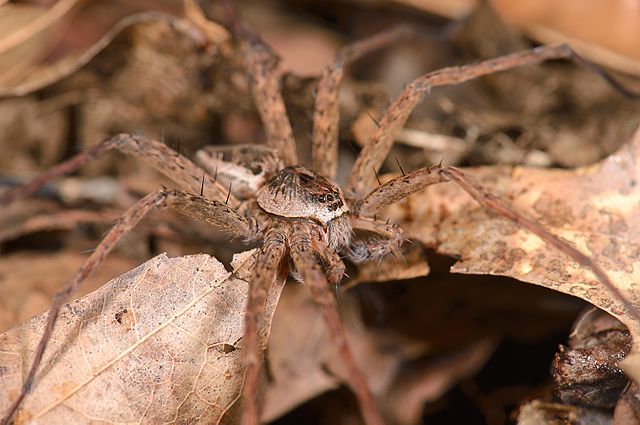
Scientific name: Dolomedes scriptus
Common name: Striped fishing spider
Female striped fishing spiders can grow to more than 6cm in leg span. Females are larger than males.
They are pale brown spiders with light stripes on their legs and down the side of their bodies.
They do possess venom which is used to subdue their prey. They are not considered harmful to humans.
29. False Black Widow

Scientific name: Steatoda grossa.
Common name: False black widow, cupboard spider.
The false black widow spider can grow to 10.5mm in body length and has a large round bulb-shaped abdomen that is dark in color. Their coloration varies from black to purple-brown with light-colored markings. They do not have a red hourglass on their belly.
A false black widow bite is considered medically significant, even though minor. There should be no long-lasting effects. Symptoms associated with their bites include muscle spasms, fever, sweating, pain, and the general feeling of unwellness, which can last for several days.
30. Long-bodied Cellar Spider

Scientific name: Pholcus phalangioides
Common name: daddy long-legs spider, long-bodied cellar spider, skull spider.
The long-bodied cellar spider is often referred to as Daddy Long Legs. These are long tubular-shaped spiders with a rounded bottom and tapered waist with long and spindly legs.
They have very bad eyesight and rely on insects getting ensnared in their webs for food. They wait for the insects to get tangled, which causes a vibration in the web.
These spiders are also known for bouncing in their web, which makes them blurry to whoever is looking at them, whether its prey or a human.
They are venomous, but their fangs are too small to inject venom into humans.
31. Minute Jumping Spider

Scientific name: Talavera minuta.
Common name: minute jumping spider.
The minute jumping spider belongs to the Salticidae family of spiders, known for being able to jump more than four times their body lengths at great speeds. They use their jumping and speed to ambush their prey, which they drag back to their web.
32. Phidippus olympus
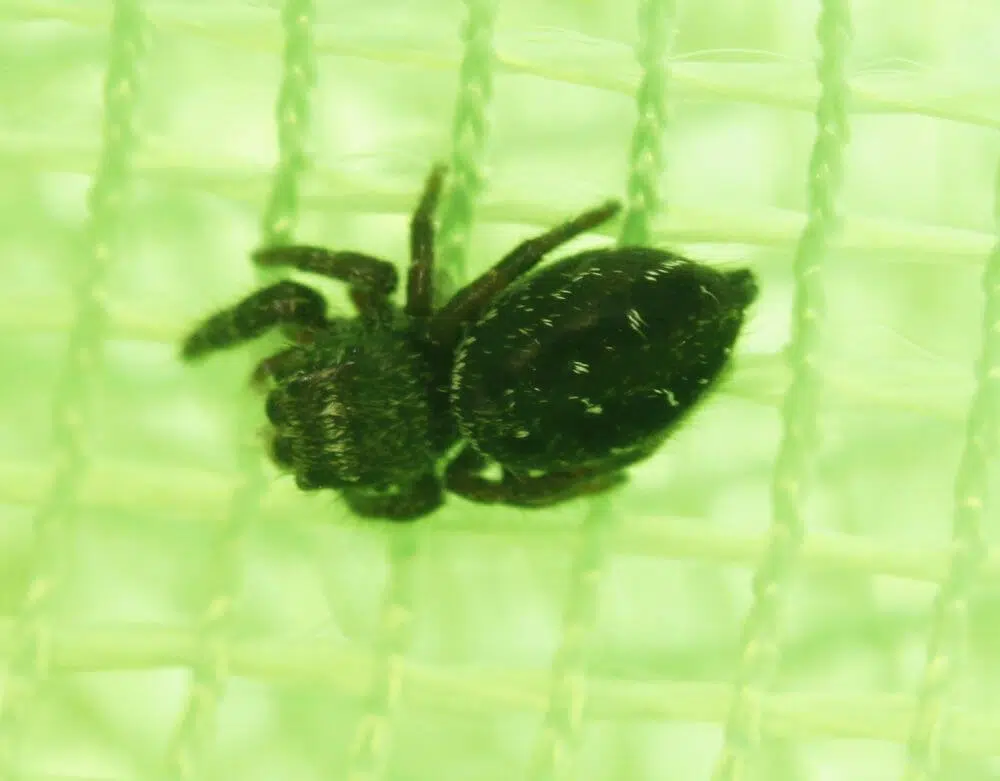
These large jumping spiders being to the Salticidae family and usually have bright green chelicerae.
They are native to North America and are harmless to humans. In fact, these spiders are great to have in or near the home and they help eradicate bugs.
33. Schizocosa mccooki

These are wolf spiders that belongs to the Lycosidae family, common in Colorado. They have eight eyes, set in three rows.
There is very limited information on this spider. Being nocturnal and a burrowing spider, it is not encountered very often.
34. Red-spotted Ant-mimic Sac Spider

Scientific name: Castianeira descripta.
Common name: Red-spotted Ant-mimic Sac Spider.
The red-spotted ant mimic spider is a hunting spider that wanders around searching for its next meal. They often walk with two front legs held in the air, giving them the appearance of an ant with antennae.
Females grow to around 13mm in body length with males being smaller.
They are aggressive but are not considered dangerous to humans and pets. The bite area may become red and swollen, with pain that is comparable to a bee sting.
If you suffer from allergies, take note of your throat and face swelling if bitten, which could be a sign of an allergic reaction that requires immediate medical attention.
Further Reading:
35. Habronattus altanus

This jumping spider is a harmless ambush spider that spins its web to protect it against predators, giving it a safe refuge and place to eat.
They can jump more than four times their body length at fast speeds, throwing out a single silk strand to entangle the prey, which they then drag back to their web and eat at their leisure.
36. Grand Canyon Black Tarantula

Scientific name: Aphonopelma marxi.
Common name: Grand canyon black tarantula.
The Grand Canyon black tarantula is black to dark brown. These hairy spiders sometimes have red hairs on the abdomen.
Females are larger than males and can grow to 35mm in body length.
Tarantulas may appear scary, due to their large size and hairy bodies, but they are harmless to humans and quite docile.
37. Six-spotted Orbweaver

Scientific name: Araniella displicata.
Common name: Six-spotted orb weaver
The six spotted orb weaver is known for its large orb-shaped webs. The spider sits upside down in the center of the web, waiting for insects to get entangled and eating small flies through the webbing.
These spiders spend most of their day remaking and repairing their webs.
38. Peppered Jumping Spider

Scientific name: Pelegrina galathea.
Common name: peppered jumper.
The female peppered jumping spider can grow to 5.4mm in body length with the male being slightly smaller with a body length of 4.4mm.
They are small and gray in color with dark and light spots, which gives them a speckled appearance, hence the name Males are brown bronze color with white patterns on the head space and abdomen.
These spiders are commonly encountered in old fields, crops, and prairies where they are excellent in controlling pests.
Further Reading: